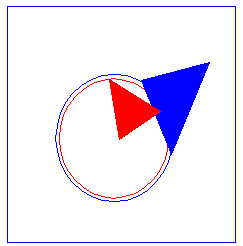You can ignore the clearance that might exists between a pair of entities for a no penetration contact formulation in the initial undeformed state of the model. This flag should be cleared (default) for most applications. It is designed to take care of special situations where a small clearance might exist between faces that should have been initially in contact.
| Ignore Clearance for Surface Contact is cleared |
In the undeformed state of the model, contact between a node and a face (or a face and a face) develops if the initial clearance between the two entities is less than or equal to a default threshold value of 0.5% of the underlying element size (for a node to surface contact). For a surface to surface contact, the default threshold value is set to 0.005% of the characteristic length of the model. If the initial gap between two entities in the undeformed state of the model exceeds this default threshold value, these entities are considered non-touching. For example, if you specify a local no penetration node to surface contact between two faces that have an initial clearance in the undeformed state of the model smaller than the preset tolerance (0.5% of the underlying element size for node to surface contact), these faces are considered to be touching with no gap between them.
The flag should not be turned on when the faces of contact sets have large curvature differences. It is recommend to apply mesh control to specify a finer mesh in contact regions.
|
| Ignore Clearance for Surface Contact is selected |
Initial contact between a node and a face, or between two faces is assumed in the initial undeformed state of the model regardless of the initial clearance between the entities. There is no limitation on the initial gap between the pair of entities for the no penetration contact sets. The faces of contact sets can move away from each other, but they cannot get any closer to each other than in the initial undeformed configuration.
|

The is a cross-section view of two cylinders with very small clearance between them: a red internal one and a blue external one. The red mesh element of the inner disc interferes with the blue mesh element of the outer disc. You can select option Ignore Clearance for Surface Contact in this case to avoid the interference between the two mesh elements.
To minimize the possibility of this situation, use mesh control to specify a finer mesh in contact regions with this condition. High quality meshes (parabolic elements) are recommended for all contact problems.
When defining a contact set between two faces (or between an edge and a face) with a very small initial physical gap between them, use option Ignore clearance only if gap is less than in the Contact Set PropertyManager. The clearance is ignored when the gap is smaller than the given value. This local setting overrides the global setting in the Static dialog box.